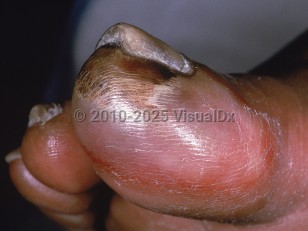- If there are systemic signs of hypothermia, core rewarming and fluid resuscitation should occur before limb rewarming to prevent hypotension and shock.
- Rapid limb rewarming should occur with bathwater temperature set to 37°C-39°C (99°F-102°F). Analgesics or narcotics should be given for pain during the process of rewarming.
- Within 24 hours of injury, tissue plasminogen activator can decrease the need for amputation.
Cold injuries can range from minor without long-term sequelae to major with significant morbidity and mortality, depending on what areas are affected and how deep the injury penetrates. Typically, the cold exposure occurs over minutes or hours, but even instantaneous exposure to cold metal can result in frostbite. At -2°C (28.4°F), cellular metabolism stops, proteins and enzymes are destroyed, and ice crystals form in the extracellular space, causing tissue damage and cell death.
Frostnip is the earliest sign of cold injury and presents with pain and pallor of the affected area, followed by numbness. With continued exposure, complete anesthesia will result. Younger children may not communicate symptoms at onset.
Many experts classify frostbite injuries as either superficial or deep, as this corresponds with a functional outcome.
- If a thumbprint is left on the skin, the condition is more superficial.
- Deeper frostbite presents with skin that is hard to the touch, and structures such as muscle, nerve, and bone may be affected.
At-risk populations:
- Children (larger body surface area to lose heat faster)
- Elderly patients
- Mentally impaired or altered individuals
- Individuals with substance use disorder, including inhalant abuse
- Outdoor athletes in cold climates
- Undomiciled individuals without access to shelter or weather-appropriate clothes
- Distal extremities (fingers and toes)
- Chin
- Nose
- Cheeks
- Ears
- Neck
- Peripheral vascular disease
- Diabetes
- Beta blockers
- Peripheral neuropathy, Raynaud phenomenon
- Prior cold exposure or previous frostbite
- High altitude – The combination of cold temperature and low ambient oxygen tension makes oxygen deprivation of tissues more severe.



 Patient Information for
Patient Information for 
